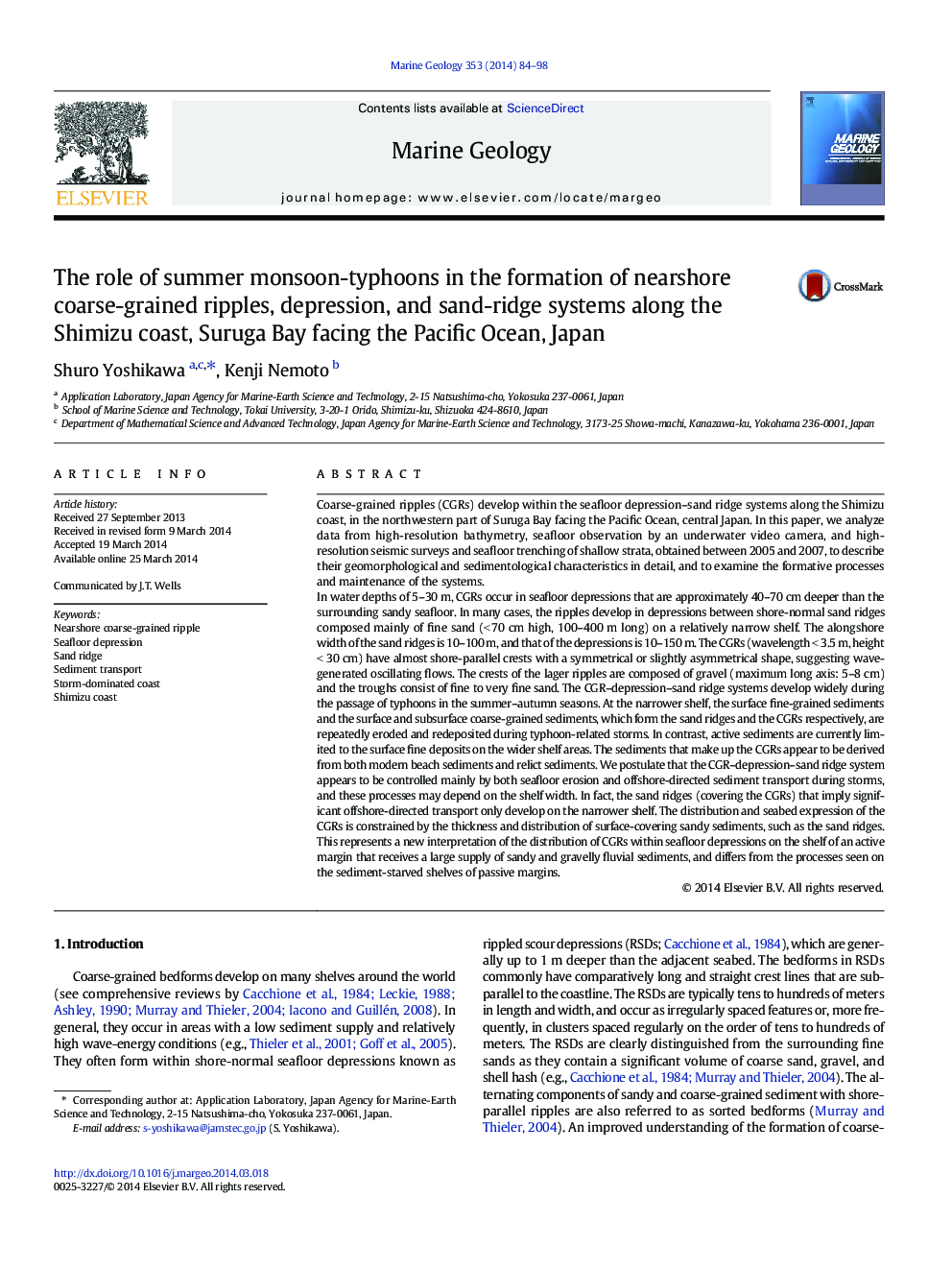| کد مقاله | کد نشریه | سال انتشار | مقاله انگلیسی | نسخه تمام متن |
|---|---|---|---|---|
| 4718296 | 1639099 | 2014 | 15 صفحه PDF | دانلود رایگان |

• We present seasonal morphological variations in nearshore coarse-grained ripples.
• Ripples within the depression–sand ridge system only occur on the narrower shelf.
• The system is significantly reorganized by typhoon-related storms.
• Morphology of sand ridges covering the ripples reveals offshore transport to canyon.
• Ripple distribution is constrained by the thickness of surface sandy deposits.
Coarse-grained ripples (CGRs) develop within the seafloor depression–sand ridge systems along the Shimizu coast, in the northwestern part of Suruga Bay facing the Pacific Ocean, central Japan. In this paper, we analyze data from high-resolution bathymetry, seafloor observation by an underwater video camera, and high-resolution seismic surveys and seafloor trenching of shallow strata, obtained between 2005 and 2007, to describe their geomorphological and sedimentological characteristics in detail, and to examine the formative processes and maintenance of the systems.In water depths of 5–30 m, CGRs occur in seafloor depressions that are approximately 40–70 cm deeper than the surrounding sandy seafloor. In many cases, the ripples develop in depressions between shore-normal sand ridges composed mainly of fine sand (< 70 cm high, 100–400 m long) on a relatively narrow shelf. The alongshore width of the sand ridges is 10–100 m, and that of the depressions is 10–150 m. The CGRs (wavelength < 3.5 m, height < 30 cm) have almost shore-parallel crests with a symmetrical or slightly asymmetrical shape, suggesting wave-generated oscillating flows. The crests of the lager ripples are composed of gravel (maximum long axis: 5–8 cm) and the troughs consist of fine to very fine sand. The CGR–depression–sand ridge systems develop widely during the passage of typhoons in the summer–autumn seasons. At the narrower shelf, the surface fine-grained sediments and the surface and subsurface coarse-grained sediments, which form the sand ridges and the CGRs respectively, are repeatedly eroded and redeposited during typhoon-related storms. In contrast, active sediments are currently limited to the surface fine deposits on the wider shelf areas. The sediments that make up the CGRs appear to be derived from both modern beach sediments and relict sediments. We postulate that the CGR–depression–sand ridge system appears to be controlled mainly by both seafloor erosion and offshore-directed sediment transport during storms, and these processes may depend on the shelf width. In fact, the sand ridges (covering the CGRs) that imply significant offshore-directed transport only develop on the narrower shelf. The distribution and seabed expression of the CGRs is constrained by the thickness and distribution of surface-covering sandy sediments, such as the sand ridges. This represents a new interpretation of the distribution of CGRs within seafloor depressions on the shelf of an active margin that receives a large supply of sandy and gravelly fluvial sediments, and differs from the processes seen on the sediment-starved shelves of passive margins.
Journal: Marine Geology - Volume 353, 1 July 2014, Pages 84–98